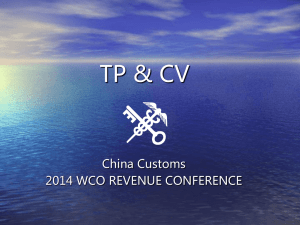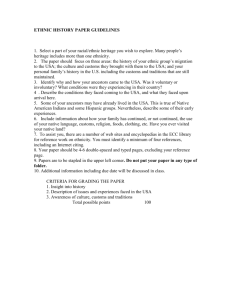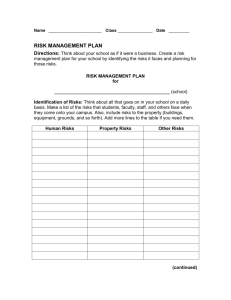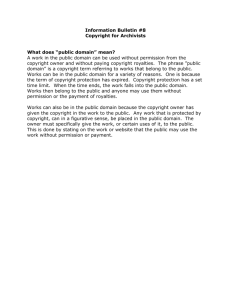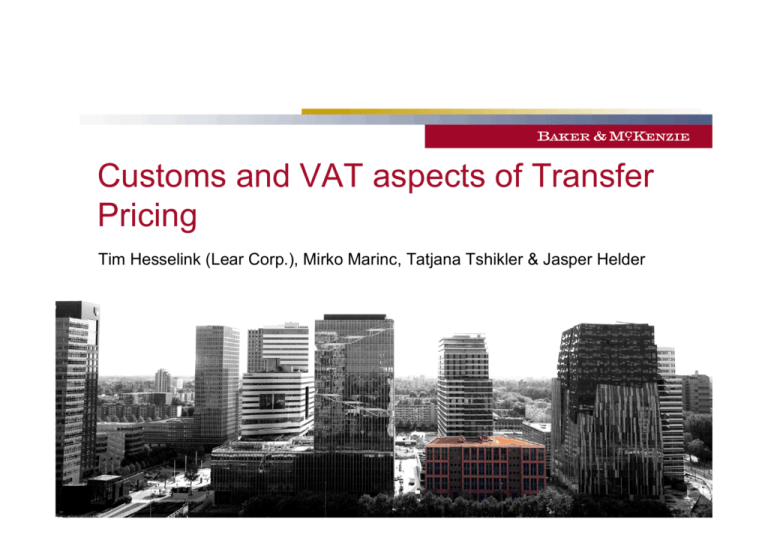
Customs and VAT aspects of Transfer
Pricing
Tim Hesselink (Lear Corp.), Mirko Marinc, Tatjana Tshikler & Jasper Helder
Ahead of Tax 2011
Transfer Pricing
Methods
Ahead of Tax 2011
2
The Methods and OECD Guidelines
OECD Transfer Pricing Methods
Traditional Transaction Methods:
Transactional Profit Methods:
Preferred Methods
Last Resort Methods
Comparable
Resale Price
Cost Plus
Transactional
Profit Split
Uncontrolled
Method
Method
Net Margin
Method
Price
Ahead of Tax 2011
Method
Contribution
Residual
Analysis
Analysis
3
Methods: order of consideration and the
overview
CUP
Prices
RPM
Gross Profit Level
CPLM
Gross Profit Level
PSM
Gross / net profit level / internal data
TNMM
Net profit level
Ahead of Tax 2011
4
Traditional transactional methods
Ahead of Tax 2011
5
Comparable Uncontrolled Price Method
Ass.
Enterprise
1
Non-related Party
A
Ahead of Tax 2011
Ass.
Enterprise
2
Non-related Party
Internal
Comparable?
Non-related Party
B
External
Comparable?
6
Comparable Uncontrolled Price Method (CUP)
The CUP method compares the price charged for property or services in
a controlled transaction to the price charged for property or services in a
comparable uncontrolled transaction in comparable circumstances:
– internal or
– external comparable
Difference in price may indicate that the conditions are not at arm’s
length.
Comparable:
– Differences do not affect open market price
– Reliable adjustments can be made to eliminate effect of
Ahead of Taxmaterial
2011
differences
7
CUP Method
In principle, this is the best method:
– your company trades in the same goods, in the same market with
independents; or
– you find a similar enterprise trading in the same goods in the
same market, at the same level in the market, and apply its prices
to your company
Hence you can apply the comparable prices to your intra-group transactions
Issues?
Ahead of Tax 2011
8
Resale Price Method (RPM)
Group
Manufacturer
B
A
Group
Distributor
Third party
customer
Look at end selling price and deduct a reasonable gross margin
to arrive at cost
Resale Price
- Resale Price x Resale price margin
Arm’s Length Price
Ahead of Tax 2011
=
=
=
€100
- €100 x 20 %
€80a
9
Financial Analysis – Impact of applying the RPM
TESTED
PARTY!
Resale – 20%
‘Residual!’
Raw
Material
€60
End
Consumer
Mfgr
€20
€60
Mfgr
€12
€60
Ahead of Tax 2011
Mfgr
€28
€80
€72
€88
Sales
Office
€100
€20
Sales
Office
€90
€18
Sales
Office
€22
€110
10
Cost Plus Method (CPLM)
– The cost plus method begins with the costs incurred by the supplier
of property or services to a related purchaser.
– An appropriate percentage mark-up is applied to the costs to give the
arm’s length profit.
– Generally the best that cost plus can do is mirror what might have
happened at arm’s length.
Examples?
Ahead of Tax 2011
11
CPLM
Associated
Enterprise 1
Associated
Enterprise 2
Arm's Length
Price ?
Arm’s Length Price
COGS Associated Enterprise 1
Gross Profit
=
=
=
Arm’s length gross profit mark-up =
Ahead of Tax 2011
?
€ 60
?
€ 55
€ 50
€5
€5/€50 = 10%
12
Financial Analysis – Impact of applying the CPLM
TESTED
PARTY!
Cost + 10%
‘Residual!’
Raw
Material
€60
End
Consumer
Mfgr
€6
€60
Mfgr
€6
€60
Ahead of Tax 2011
Mfgr
€6
€66
€66
€66
Sales
Office
€100
€34
Sales
Office
€90
€24
Sales
Office
€110
€44
13
Evaluation of traditional methods
− Traditional methods: focus on transaction
− CUP takes into account both buyer and seller
while Cost-plus / Resale price are one-sided
approaches
− CUP requires product comparability while Costplus and Resale price require functional
comparability
Ahead of Tax 2011
14
Transactional profit methods
Ahead of Tax 2011
15
Transactional Profit Methods
Examine the profits arising from particular controlled transactions
Not the preferred approach (in exceptional cases)
Usually viewed as method of last resort
Should only be used if traditional methods are inappropriate or cannot be applied (e.g.
insufficient or unreliable data on uncontrolled transactions)
Often a useful check on accuracy/ reasonableness of other methods where the information
is available. However:
– often more commonly used as more practical
– easier to find comparables in practice
Ahead of Tax 2011
16
Transactional Net Margin Method (TNMM)
Associated
Enterprise 2
Associated
Enterprise 1
Tested Party?
Least Complex
Nonrelated
Party
Price is
Given
Given Price
=
$100
COGS
=
?
Gross Profit
=
?
Operating Expenses
=
$ 14
Operating Profit
=
?
Arm’s Length Operating Profit Margin = 6%
Ahead of Tax 2011
$100
$ 80
$ 20
$ 14
$ 6
17
TNMM and Profit Level Indicator (“PLI”)
– The TNMM analyzes the net profit margin relative to an appropriate
base (e.g., costs, sales, assets) realized by a company from a controlled
transaction (or transactions that are appropriate to aggregate)
– Several profit level indicators are allowed under the TNMM, which are
all based on the operating profit:
– Operating profit margin
– Return on Total Costs
– Return on (Operating) Assets
– (Berry ratio = Gross Profit / Operating Expenses)
Ahead of Tax 2011
Profit Split Method (PSM)
Use of the profit split method
– When the transactions are so interrelated that they can not be
evaluated on separated basis
– When the CUP, RPM and Cost Plus methods are not applicable
in practice
This method must be distinguished from the global formulary apportionment
Ahead of Tax 2011
19
PSM - OECD principles
The contribution profit split method
– Allocation of the profit of transactions between the contracting
related parties on the basis of an arm’s length economic
agreement
The residual profit split method
– Step 1 : allocation of “routine” profit for each contracting party
– Step 2 : allocation of residual profit (or loss) between the
related parties
– Method more commonly used than the contribution profit split
method
Ahead of Tax 2011
20
PSM : example
country A
country
B
100 =
correct TP?
sales
100
150
purchases
(20)
(100)
manufact costs
(50)
(25)
gross profit
30
25
R&D expenses
(15)
(5)
operating expense
(5)
(5)
operating profit
10
15
Ahead of Tax 2011
21
Customs Valuation
Ahead of Tax 2011
22
General Rule:
The Transaction Value
(A) The transaction value
+
(B) Additions
(= price actually paid or payable; Art. 29
CCC)
(= elements as listed in Art. 32 CCC)
./.
(C) Deductions
=
(= elements as listed in Art. 33 CCC)
CUSTOMS VALUE
Ahead of Tax 2011
23
General Rule:
The Transaction Value
–Existence of a sale of goods;
–Sale for export into the EU;
–Cash or kind – direct or indirect payments
Ahead of Tax 2011
24
General Rule:
The Transaction Value
– The transaction value shall only be accepted, if
– The buyer and the seller are not related, or
– The buyer and the seller are related, but the relationship did not
influence the price (i.e. the transaction value is found to be
acceptable).
– Customs has to outline specific reasons for influence of price due to
relationship.
– Burden is then on importer to establish does not affect the price
(“Related Party Test“).
Ahead of Tax 2011
25
Related Part Test
– Aim: Demonstration that sales price meets arm‘s length principles
– Examination of the „circumstances of the sale“ of the imported goods,
e.g.
– Price reflects the normal pricing practice for the industry;
– Evidence that the parties negotiated „over price“;
– Selling price includes all costs plus an amount for profit and general
expenses.
– Question: Can accepted Transfer Price (built according to the OECD
principles) serve for Related Party Test?
Ahead of Tax 2011
26
Additions to the Selling Price
(Art. 32 CCC)
The most relevant ones are:
–Commissions and Brokerage;
–Assists;
–Royalties and License Fees;
–Transportation and Insurance Charges
(to the port or place of importation)
… if not yet included in the selling price.
Ahead of Tax 2011
27
Deductions from the
Selling Price (Art. 33 CCC)
The most relevant ones are:
–Transportation charges after importation;
–Duties and taxes of the country of importation;
–Financing interest;
–Buying commission.
Ahead of Tax 2011
28
Alternative Valuation Methods
– No „price actually paid or payable“ available (e.g. lease, rent, import
for supplier‘s own disposal);
– Failure of Related Party Test;
Alternative Valuation Methods
–
–
–
–
–
!
Transaction Value of identical goods;
Transaction value of similar goods;
Deductive valuation method
Computed valuation method
Estimate (along the lines of alternative valuation methods).
Prescribed order! Only Deductive and computed valuation method can
be changed upon application!
Ahead of Tax 2011
!
29
Consideration of
Customs Aspects in
Transfer Pricing
Ahead of Tax 2011
30
Example: Royalties
Manufacturing Inc.
• Manufacturing IP
• Registered
Trademarks
• 3rd Party Costs
(e.g. Marketing,
Research)
• Management
Know-How
Ahead of Tax 2011
Distribution GmbH
}
Royalty Agreement:
6% of net sales
Sales Invoice:
Sales Invoice:
100.000 US$
150.000 US$
FoB Bremen
+ 28.500 VAT
31
Example: Royalties
Customs value:
Sales Prize
Royalty
Customs Value
Ahead of Tax 2011
100.000 US$
9.000 US$
?
109.000 US$
32
Example: Royalties
–Definition of Royalties (Art. 157 CCIP)
Payment for the use of rights relating to
– The manufacture of imported goods (e.g.
patents, designs, models, know-how);
– The sale for exportation of imported goods (e.g.
trademarks, registered designs);
– The use or sale of imported goods (copyright,
manufacturing process).
Ahead of Tax 2011
33
Example: Royalties
–Conditions for additions
– Royalties must related to the goods being
valued (i.e. the imported goods);
– Payment of Royalties constitutes a „condition
for sale“ of the goods
Ahead of Tax 2011
34
Example: Royalties
Manufacturing Inc.
Royalty?
• Manufacturing IP
Yes
• Registered
Trademarks
Yes
• 3rd Party Costs
(e.g. Marketing,
Research)
No
• Management
Know-How
No
Possibility to exclude portions of the Royalty from customs value
Separate allocation key required
Ahead of Tax 2011
35
Example: Royalties
– Additional charges must not be regarded as part of the purchase price
for the goods.
– Otherwise: Additional charges are dutiable as part of the purchase
price.
Ahead of Tax 2011
36
Royalties (MCCIP)
Added to customs value if
– Payment is Condition of Sale (“CoS”)
–
–
–
–
Payment is required by seller/related company
Payment is made to fulfil obligation of seller
Goods may not be sold/produced without royalty-payment (new)
Distribution royalties excluded if not CoS
– Related to imported goods
– If rights for which royalties are paid are embodied in goods (new)
Ahead of Tax 2011
37
Customs Impact of
Transfer Pricing
Adjustments
Ahead of Tax 2011
38
Price Adjustments
1) Retroactive price adjustments agreed after
importation (e.g. rebates not required under
contract)
No influence on customs value
2) Retroactive price adjustments agreed before
importation
Obligation to correct customs value
Ahead of Tax 2011
39
Price Review Clauses
and Formula Pricing
– E.g. goods are valued under a cost-plus contract, but costs
are not yet available at the time of importation
– Issue: (Definite) determination of customs value at time of
importation
– Technical committee on customs valuation:
– Possibility of delaying the final determination of customs
value
– Reason: Later compensatory adjustments are
necessary for related parties to ensure arm‘s length
character
Ahead of Tax 2011
40
Price Review Clauses
and Formula Pricing continued
– Price review of adjustment clauses allow use of
transaction value method for elated parties
– Obligation for importer to correct (preliminary) customs
value!
– Importer should declare price adjustment clauses to
customs at import.
Ahead of Tax 2011
41
Audit Defense
–Generally no established cooperation
between tax (TP) and customs
administration in the EU
No automatic adjustments
No automatic exchange of information
Up to taxpayer to check risks and chances!
Ahead of Tax 2011
42
Audit Defense
– Price adjustment by decrease of TP
Possibility of refund, if
– Agreed in advance
– Assignable to past imports
– Price adjustment by increase of TP
Generally obligation for payment of additional duties, if
– Agreed in advance;
– Assignable to past imports.
Ahead of Tax 2011
43
VAT
Ahead of Tax 2011
44
VAT transfer pricing rules
and status in Europe –
another complexity as a
result of adjustments
Ahead of Tax 2011
45
VAT transfer pricing rules and status in Europe
– another complexity as a result of
adjustments
-
What kind of adjustments?
-
Issue at stake: do/should transfer pricing
adjustments affect VAT filings and Customs
valuation?
-
An unexpected layer of complexity
-
Article 80 of Directive
Ahead of Tax 2011
46
VAT transfer pricing rules and status in Europe
– another complexity as a result of
adjustments
–
–
–
–
–
–
Invoicing
VAT returns
European Sales Listing
Intrastat
Penalties for non-compliance can go up to 200% of the tax due
Other consequences: local VAT may not be refundable
– Countries that do not recover VAT
– Deadlines for VAT recovery are not met
Ahead of Tax 2011
47
VAT transfer pricing rules and status in Europe
– another complexity as a result of
adjustments
Some input from countries:
Austria - tax base should be adjusted
Bulgaria – no clear legislation – ruling?
Czech – issue invoices and declare in VAT return
France – adjustment must be made – no Intrastat adjustment
Germany – usually a service and VAT may not be recoverable
Netherlands – related to goods or services?
Portugal – each individual VAT return should be amended
Romania – only allowed in case Customs authorities agree, l.p.i., EC sales list
UK – if no clear link to service (penalty), Intrastat adjustments – criminal offense
Ahead of Tax 2011
48
Recent Case Law
– ECJ “Weald Leasing Ltd”, C-103/09
– At arm’s length for VAT?
– Abuse of law
– Proposals
Ahead of Tax 2011
49
TP, Customs and
VAT in Practice
Ahead of Tax 2011
50
Contact
Mirko Marinç
Tax advisor, VAT
Mirko,marinc@bakermckenzie.com
+31 20 551 7825
Ahead of Tax 2011
Tatjana Tsikhler
Tax advisor, Transfer Pricing
Tatjana.tsikhler@bakermckenzie.com
+31 20 551 7482
Jasper Helder
Partner, Customs & International Trade
Jasper.helder@bakermckenzie.com
+31 20 551 7579
51
© 2011 Baker & McKenzie. All rights reserved. Baker & McKenzie International is a Swiss Verein with member law firms around the world. In
accordance with the common terminology used in professional service organizations, reference to a “partner” means a person who is a
partner, or equivalent, in such a law firm. Similarly, reference to an “office” means an office of any such law firm.
Ahead of Tax 2011
52



